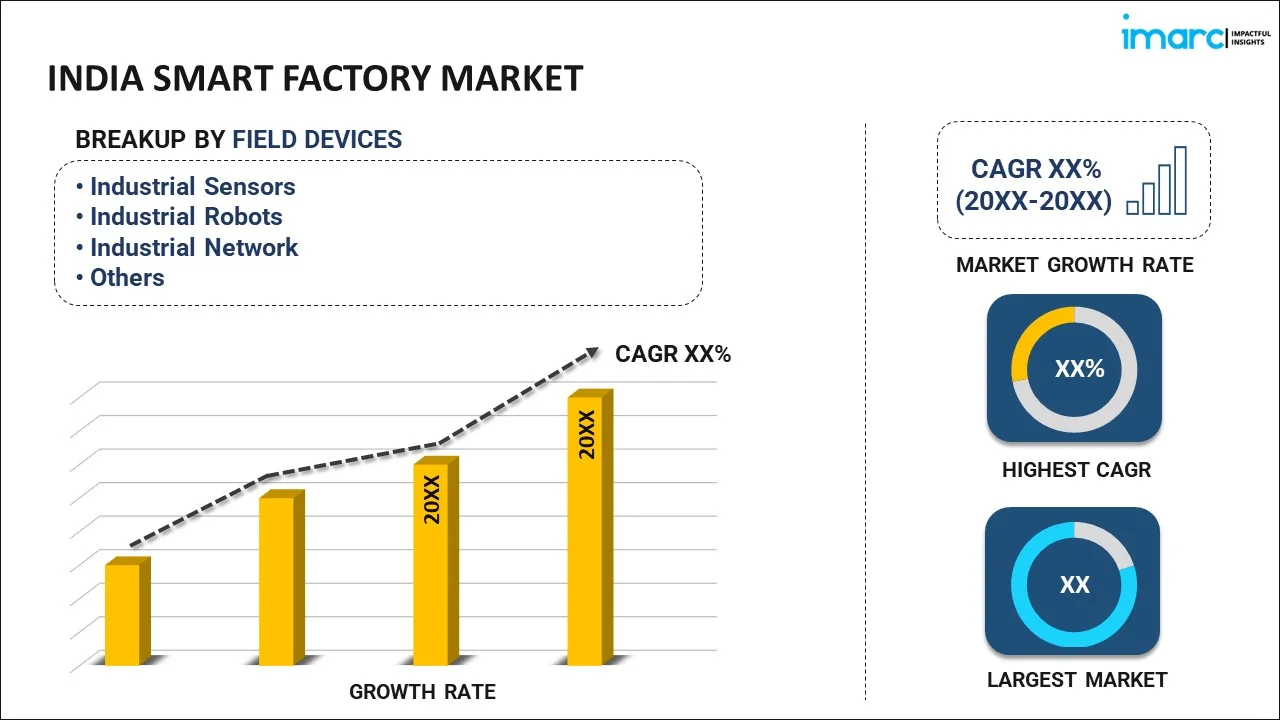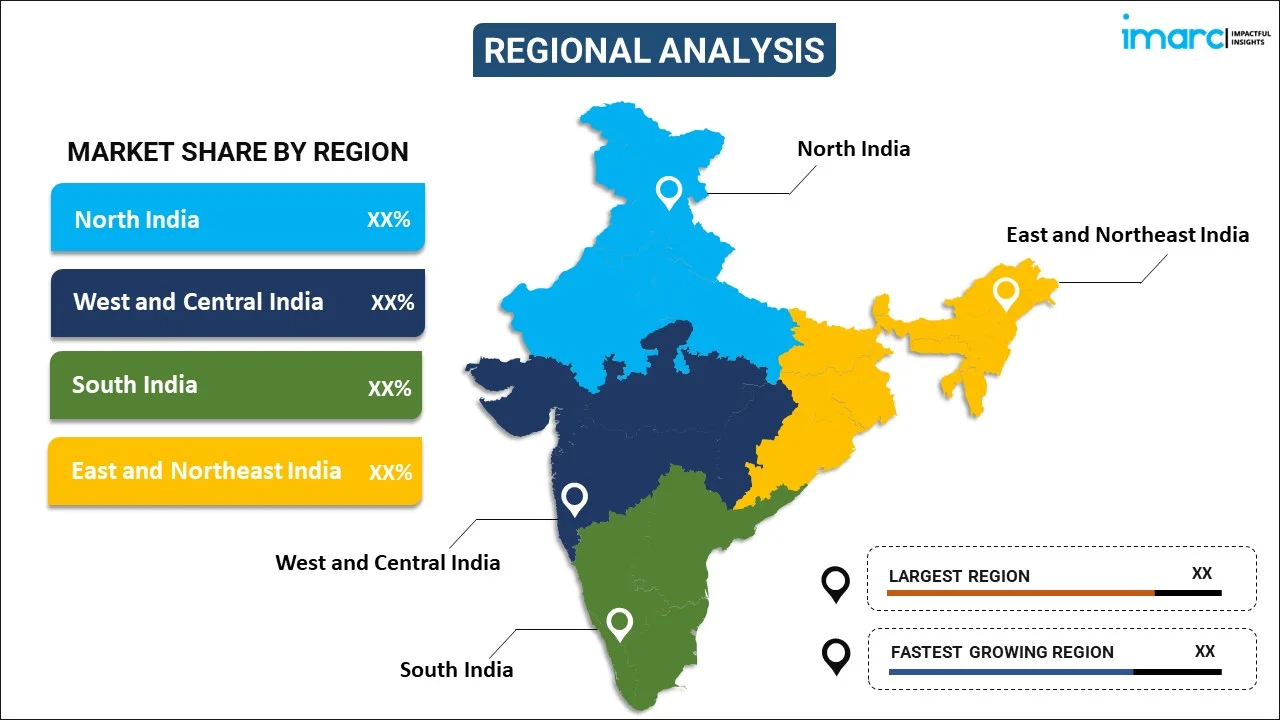
India Smart Factory Market Report by Field Device (Industrial Sensors, Industrial Robots, Industrial Network, Industrial 3D Printers, Machine Vision Systems), Technology (Product Lifecycle Management (PLM), Human Machine Interface (HMI), Enterprise Resource Planning (ERP), Manufacturing Execution Systems (MES), Distributed Control Systems (DCS), Industrial Control System, and Others), End Use Industry (Pharmaceuticals, Food and Beverages, Chemical, Oil and Gas, Automotive and Transportation, Semiconductor and Electronics, Aerospace and Defense, and Others), and Region 2024-2032
Market Overview:
India smart factory market size is projected to exhibit a growth rate (CAGR) of 11.40% during 2024-2032. The integration of physical processes with computer-based algorithms and control systems, which enhances communication and coordination within the manufacturing environment, leading to improved productivity and responsiveness, is driving the market.
|
Report Attribute
|
Key Statistics
|
|---|---|
|
Base Year
|
2023 |
|
Forecast Years
|
2024-2032 |
|
Historical Years
|
2018-2023
|
| Market Growth Rate (2024-2032) | 11.40% |
A smart factory refers to a manufacturing facility that leverages advanced technologies such as the Internet of Things (IoT), artificial intelligence (AI), robotics, and data analytics to optimize its operations and improve overall efficiency. In a smart factory, machines and systems are interconnected, allowing real-time communication and collaboration. This integration enables streamlined production processes, predictive maintenance, and data-driven decision-making. Automation plays a crucial role in enhancing productivity while reducing errors and operational costs. The smart factory concept aims to create a more agile and adaptive manufacturing environment capable of responding rapidly to changing market demands. By harnessing the power of digital technologies, smart factories pave the way for a more sustainable, connected, and intelligent future of manufacturing.
India Smart Factory Market Trends:
The smart factory market in India is experiencing robust growth, primarily propelled by the escalating demand for automation and advanced manufacturing technologies. Furthermore, the increasing emphasis on operational efficiency and cost reduction has driven manufacturers to adopt smart factory solutions. To elaborate, the integration of Industrial Internet of Things (IIoT) devices and sensors allows real-time data monitoring and analysis, thereby optimizing production processes. Additionally, the seamless connectivity facilitated by 5G technology enhances communication and coordination between different components of a smart factory. Moreover, the rising trend towards Industry 4.0, characterized by the convergence of digital technologies, artificial intelligence, and machine learning, is a key driver in the smart factory market. This paradigm shift towards intelligent and interconnected manufacturing systems results in heightened productivity and resource utilization. Concurrently, the growing awareness of sustainability and environmental concerns has prompted companies to adopt smart factory solutions to minimize waste and enhance energy efficiency. In essence, the confluence of these factors is propelling the regional smart factory market forward, ushering in a new era of highly efficient, interconnected, and technologically advanced manufacturing ecosystems.
India Smart Factory Market Segmentation:
IMARC Group provides an analysis of the key trends in each segment of the market, along with forecasts at the country level for 2024-2032. Our report has categorized the market based on field devices, technology, and end use industry.
Field Devices Insights:

- Industrial Sensors
- Industrial Robots
- Industrial Network
- Industrial 3D Printers
- Machine Vision Systems
The report has provided a detailed breakup and analysis of the market based on the field devices. This includes industrial sensors, industrial robots, industrial network, industrial 3D printers, and machine vision systems.
Technology Insights:
- Product Lifecycle Management (PLM)
- Human Machine Interface (HMI)
- Enterprise Resource Planning (ERP)
- Manufacturing Execution Systems (MES)
- Distributed Control Systems (DCS)
- Industrial Control System
- Others
A detailed breakup and analysis of the market based on the technology have also been provided in the report. This includes product lifecycle management (PLM), human machine interface (HMI), enterprise resource planning (ERP), manufacturing execution systems (MES), distributed control systems (DCS), industrial control system, and others.
End Use Industry Insights:
- Pharmaceuticals
- Food and Beverages
- Chemical
- Oil and Gas
- Automotive and Transportation
- Semiconductor and Electronics
- Aerospace and Defense
- Others
The report has provided a detailed breakup and analysis of the market based on the end use industry. This includes pharmaceuticals, food and beverages, chemical, oil and gas, automotive and transportation, semiconductor and electronics, aerospace and defense, and others.
Regional Insights:

- North India
- West and Central India
- South India
- East and Northeast India
The report has also provided a comprehensive analysis of all the major regional markets, which include North India, West and Central India, South India, and East and Northeast India.
Competitive Landscape:
The market research report has also provided a comprehensive analysis of the competitive landscape. Competitive analysis such as market structure, key player positioning, top winning strategies, competitive dashboard, and company evaluation quadrant has been covered in the report. Also, detailed profiles of all major companies have been provided.
India Smart Factory Market Report Coverage:
| Report Features | Details |
|---|---|
| Base Year of the Analysis | 2023 |
| Historical Period | 2018-2023 |
| Forecast Period | 2024-2032 |
| Units | US$ Million |
| Scope of the Report | Exploration of Historical Trends and Market Outlook, Industry Catalysts and Challenges, Segment-Wise Historical and Future Market Assessment:
|
| Field Devices Covered | Industrial Sensors, Industrial Robots, Industrial Network, Industrial 3D Printers, Machine Vision Systems |
| Technologies Covered | Product Lifecycle Management (PLM), Human Machine Interface (HMI), Enterprise Resource Planning (ERP), Manufacturing Execution Systems (MES), Distributed Control Systems (DCS), Industrial Control System, Others |
| End Use Industries Covered | Pharmaceuticals, Food and Beverages, Chemical, Oil and Gas, Automotive and Transportation, Semiconductor and Electronics, Aerospace and Defense, Others |
| Regions Covered | North India, West and Central India, South India, East and Northeast India |
| Customization Scope | 10% Free Customization |
| Report Price and Purchase Option | Single User License: US$ 2699 Five User License: US$ 3699 Corporate License: US$ 4699 |
| Post-Sale Analyst Support | 10-12 Weeks |
| Delivery Format | PDF and Excel through Email (We can also provide the editable version of the report in PPT/Word format on special request) |
Key Questions Answered in This Report:
- How has the India smart factory market performed so far and how will it perform in the coming years?
- What has been the impact of COVID-19 on the India smart factory market?
- What is the breakup of the India smart factory market on the basis of field devices?
- What is the breakup of the India smart factory market on the basis of technology?
- What is the breakup of the India smart factory market on the basis of end use industry?
- What are the various stages in the value chain of the India smart factory market?
- What are the key driving factors and challenges in the India smart factory?
- What is the structure of the India smart factory market and who are the key players?
- What is the degree of competition in the India smart factory market?
Key Benefits for Stakeholders:
- IMARC’s industry report offers a comprehensive quantitative analysis of various market segments, historical and current market trends, market forecasts, and dynamics of the India smart factory market from 2018-2032.
- The research report provides the latest information on the market drivers, challenges, and opportunities in the India smart factory market.
- Porter's five forces analysis assist stakeholders in assessing the impact of new entrants, competitive rivalry, supplier power, buyer power, and the threat of substitution. It helps stakeholders to analyze the level of competition within the India smart factory industry and its attractiveness.
- Competitive landscape allows stakeholders to understand their competitive environment and provides an insight into the current positions of key players in the market.
Need more help?
- Speak to our experienced analysts for insights on the current market scenarios.
- Include additional segments and countries to customize the report as per your requirement.
- Gain an unparalleled competitive advantage in your domain by understanding how to utilize the report and positively impacting your operations and revenue.
- For further assistance, please connect with our analysts.
 Inquire Before Buying
Inquire Before Buying
 Speak to an Analyst
Speak to an Analyst
 Request Brochure
Request Brochure
 Request Customization
Request Customization




.webp)




.webp)












